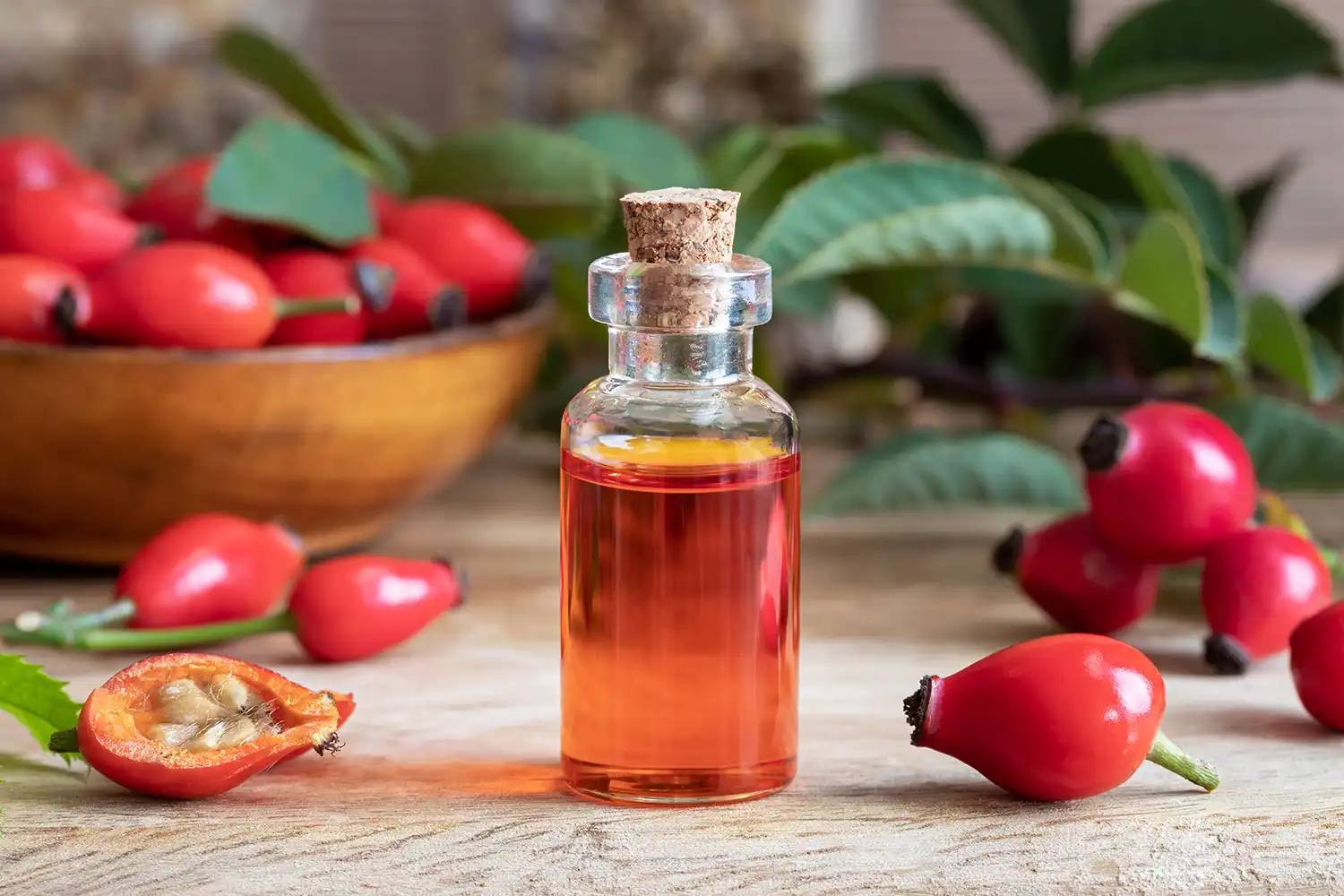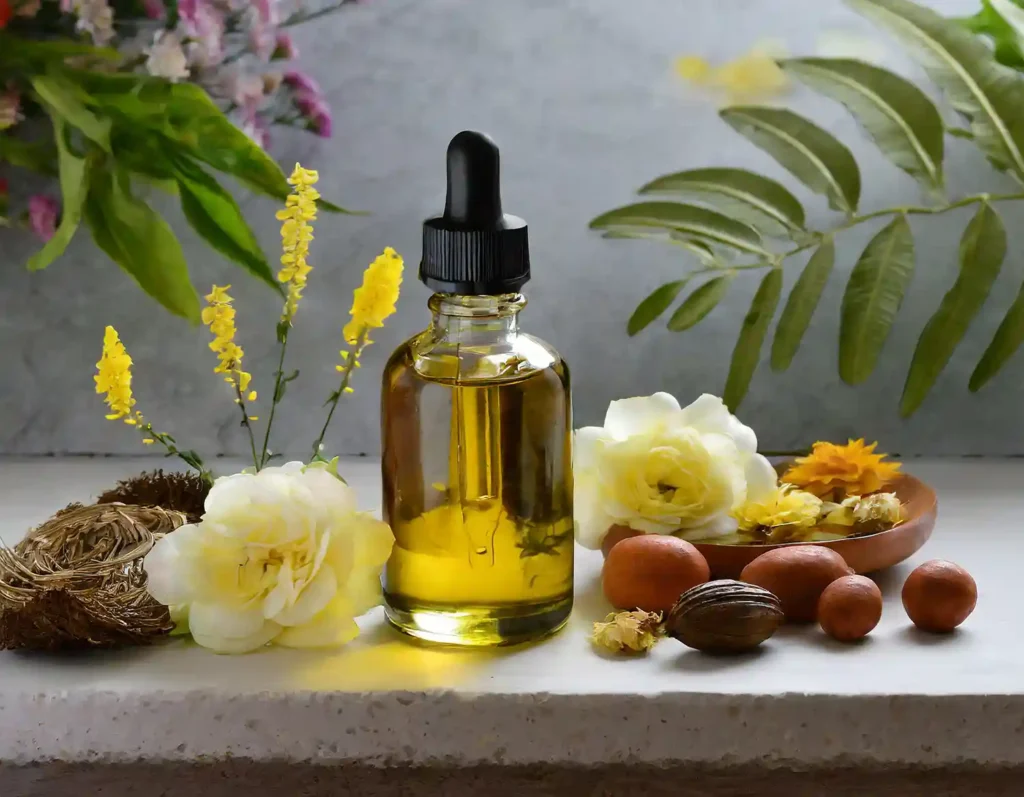Carrier oils are a vital part of any essential oil regime. They are frequently blended with essential oils, thus making the essential oils safer to use and more effective. However, carrier oils also have many benefits on their own, providing the skin with essential fatty acids, fat-soluble vitamins and antioxidants.
This guide will teach you all you need to know about carrier oils, including how to use them, the best ones, and their many benefits!
What is a carrier oil?
Carrier oils (also known as vegetable oils, fixed oils, or base oils) are naturally derived from the fatty parts of plants such as nuts, seeds, and kernels. Unlike essential oils, these oils are relatively tolerant to oxygen and do not evaporate in the same way that essential oils do.
They are given the term ‘carrier oil‘ as they carry essential oils onto the skin. In almost all cases, you should dilute essential oils before applying them to your skin. When used carelessly, many essential oils can cause severe irritation, sensitisation, and redness when applied undiluted to the skin. It is very important to use essential oils safely.
Most carrier oils naturally have very little aroma and may occasionally smell very slightly “oily”. This does not affect how they can be used on the skin, as the slight aroma does not become noticeable. Other carrier oils, such as olive oil or avocado oil, have a more distinct aroma. It is important to be aware of this when using these carrier oils so that you do not cause unpleasant fragrance combinations when applying essential oils.
The carrier oils themselves have beneficial properties that may help improve skin tone, reduce the appearance of large pores and promote the natural function of your skin cells. They provide the skin with naturally occurring vitamins, minerals and antioxidants which protect the skin and keep it healthy. The fatty acids are more commonly known as Omega-9, Omega-6 and Omega-3 and are well known for being excellent at improving your overall health and your skin.
Processing methods
Many carrier oils are sold as “cold pressed“. This is where the nuts or seeds have had a slow pressing that does not generate much heat. This preserves more of the oil’s natural benefits than an oil heated to a high temperature. Cold pressing retains more of that warm, natural, nutty aroma with hazelnut and walnut oil.
Macerated oils
Carrier oils can also include ‘macerated oils’. These oils have had dried herbs macerated in them for a period of time and then strained. The vegetable oil used for maceration can vary, but usually, it is stable oils that are selected, such as sunflower or jojoba oils. Partly because the maceration process is lengthy and makes the infused oil more expensive to buy, you really want your macerated oil to have a good shelf life. Such oils are Calendula oil, Comfrey oil, Chickweed oil, Mullein Flower oil and St. John’s Wort oil.
Avoid mineral oils
As a side note, you will often come across the term “mineral oil” in some commercial products. This is an oil that has been processed from an often unknown source. It could be from the petroleum industry, from stocks of vegetable oils that have gone rancid and also from fish guts. It will always be from the cheapest source. After it has been processed, bleached and deodorised, it is generically known as mineral oil…
Most carrier oils in natural cosmetics and aromatherapy will not be treated at high temperatures. It is usually cooking oils that are extracted this way, so we recommend not buying them for use on your skin.

What are some of the benefits of using carrier oils in aromatherapy?
Carrier oils are a type of oil that is used to dilute essential oils before they are applied to the skin. Each vegetable oil has its unique properties and benefits. They are also beneficial on their own, providing the skin with essential nutrients and antioxidants.
Most people first become aware of carrier oils in holistic aromatherapy when they experience massage oils. A great blend of oils to make a massage oil will give enough slip and slide for the therapist to work their magic but also leave your skin feeling soft and not sticky.
Some of the benefits of using carrier oils include:
They are moisturising: Carrier oils help lock moisture into the skin, which can be especially beneficial for dry skin.
They are nourishing: Carrier oils provide the skin with essential fatty acids and vitamins, which can help to keep it toned, healthy and looking young.
They are anti-inflammatory: Carrier oils can help reduce skin inflammation, which can be helpful for those who suffer from conditions like eczema or rosacea.
They are antioxidants: Carrier oils contain antioxidants that increase the oil’s shelf life but, more importantly, help protect the skin from damage caused by free radicals. Flaxseed oil is rarely used in skincare products as it goes rancid so quickly. Flax seeds are good for your digestive health but steer clear of Flaxseed oil for creams and lotions.
They are versatile: Carrier oils can be used in various ways, such as face and body oils, facial cleansers, or hair treatments to promote hair growth.
What is the difference between essential oil and carrier oil?
There are a few key differences between essential oils and carrier oils that are important to understand.
- Carrier oils are typically pressed from plants, nuts, or seeds. They have their own unique benefits and essential fatty acid profiles. They have many well-known health benefits, and depending on the skin, they can be helpful when coping with large pores and skin tone and rejuvenating dull and tired skin.
- Essential oils, however, are concentrated extracts of different parts of plants, like the bark, leaves, flowers, or roots. Most frequently, they are extracted by steam distillation, but there are other methods, such as CO2 extraction. The essential oils have differing terpene profiles and are used for various purposes, including aromatherapy, massage therapy, natural skincare and inhalation via diffusers.
Do all essential oils need carrier oil?
Pretty much, yes. You can use a drop of Lavender essential oil neat on your temples to help shift a headache. Tea Tree essential oil can be used directly on the odd spot and pimple to help control acne breakouts. For the most part, though, always use essential oils correctly diluted. The correct dilution may vary greatly depending on the essential oil chosen and what part of your body the oil will be applied to.

What are the best carrier oils for essential oils?
Many carrier oils are available, each with its unique set of benefits. For example, an excellent carrier oil for full body massage, because it has a lot of slip, may not be such a great carrier oil to use on your face.
Let’s explore some of the most popular carrier oils found in aromatherapy:
Apricot oil (Apricot kernel oil)
Apricot oil is a clear, pale yellow oil that is practically odourless. It is obtained by expelling the kernel (stone) of the ripe apricot fruit. It has properties and characteristics very similar to peach kernel oil.
It can be used neatly on the skin and is excellent for irritated skin. Even sensitive skin tolerates Apricot oil well, and it is a favourite carrier oil for babies.
It is heat stable, so it can be used in the heated fat stage when creating creams and lotions.
Tip… Consider blending it with rosehip oil or chia seed oil, which are also excellent oils for use on sensitive skin.
Argan oil
This clear, yellow oil is a little thicker in texture and has a slightly nutty scent. It’s extracted from pressing seeds from the tree’s fruit. This is a classic oil often used in cosmetics for skin and hair. Goats eat the fruits and then excreted, and although the collected nuts are well washed before pressing, they can still have a slight “farmyard” aroma, which is easily covered by adding essential oils.
Argan oil is packed with vitamins, phenols, carotenoids, and essential fatty acids that nourish the skin and scalp. This nourishing oil helps ward off free radicals and strengthens the immune system. Using Argan oil regularly helps keep your skin smooth and radiant and may help diminish your wrinkles.
Tip… Blending it with Camellia Seed and Pomegranate Seed oil makes incredible eye serums and creams. It is a natural partner with Avocado oil for dry and mature skin.
Avocado oil
Avocado oil is produced from the fleshy pulp of the avocado fruit. It is usually cold-pressed and then refined. This process helps remove any undesirable aroma and colour and helps to enhance the shelf life of the oil. It is a heat-tolerant oil, so it can be used in the heated oil phase when making creams and lotions.
It is often used in products for mature and ageing skin, but it is just as beneficial to dry and flaky skin. Rich in fat-soluble vitamins and minerals, it is highly nutritious for tired and dull-looking skin. It may help keep the skin supple and young-looking for longer. It is also brilliant to use with Camelina oil for an intensive hair serum.
Tip… Mixing Avocado oil with Oat and Borage oil makes for a powerfully effective dry skin serum.
Coconut oil (Fractionated Coconut oil)
Coconut oil is a very stable, liquid oil with a much drier feel and less greasiness than regular coconut oil – which is also often sold as coconut butter. Solid coconut oil has been steam treated to remove the unstable fatty acid chains that cause rancidity and greasiness. This makes the liquid oil much more elegant and usable.
Fractionated coconut oil is an excellent moisturiser for the skin, keeping it hydrated and flexible. It softens the skin and is often used in massage oil blends for its therapeutic properties and because the oil tends not to stain fabrics and washes out of the towels easily.
Of course, it is most well known for its use in hair products, making the hair shiny.
Tip… It is frequently used to extract CBD from cannabis, but for regular skincare use, try blending it with very dry-feeling oils like Rosehip or Kiwi Seed oil that are best diluted and could feel tight on the skin if used alone.
Grapeseed oil
Grapeseed oil is a clear yellow to light green colour with a faint odour easily absorbed into the skin. It is non-greasy with a fine, light texture and is made by pressing the grapes’ seeds collected from the wine-making industry – great upcycling!
The oil is then refined and winterised, which removes some of the wax from the oil. This makes the finished oil clearer, lighter and much more elegant to use on the skin.
Again, it is heat tolerant, so it can be used in the heated oil stage when making creams and lotions. It has a slight astringent effect on the skin, benefiting mature skin types as it also tones and tightens the skin.
Tip… It can effectively bulk out small amounts of other oils perfect for mature skin care, such as Pomegranate Seed oil.
Hazelnut oil
This is the first choice oil to use on acne-prone skin that is often oily and may even have become sensitive. Hazelnut oil is a clear, yellow oil with a nutty aroma because it is pressed from hazelnuts. Obviously, be aware of this for anyone who has a nut allergy. It is heat stable and can be used in the heated oil stage when making creams and lotions.
Tip… The perfect companion to this oil is Jojoba, which has a chemical profile similar to sebum. As such, it helps dissolve blackheads and unblock blocked pores, while the Hazelnut treats the oily skin. This also potentially helps to minimise skin infections and further breakouts.
Hemp Seed oil
This is a dark, olive green oil, almost khaki. It has a nutty, earthy aroma that is slightly oily. Despite this, it is a lovely oil to use. It is not a heat-stable oil, so it should only be used in the cool-down stage when making creams and lotions.
Hemp Seed oil feels very dry and not greasy when applied to the skin. This makes it ideal for skin irritations as it restores moisture to dry skin and keeps it supple. It has a very balanced profile of Omega-9 (Oleic acid), Omega-6 (Linoleic acid) and Omega-3 (Linolenic acid) essential fatty acids. This combination brings many well-known health benefits to your body and your skin.
It is superb to use in an anti-ageing face serum, where it can start to combat fine lines and wrinkles. It feels so light on the skin that it will not make the skin feel heavy, sinking into the skin quickly. Some consider it the best carrier oil for men’s facial products because it sinks quickly. The dry skin feel means it can be combined with fattier feeling oils like Shea Butter oil to still achieve an elegant skin feel.
Tip… You can make an incredible hair pack for damaged and brittle hair by blending it with Jojoba oil and protecting the hair shaft from further damage from heated hair devices.
Jojoba oil
Jojoba oil is one of the best carrier oils for people with oily skin. It helps regulate sebum production and is very good for unblocking pores and keeping acne skin clear of blemishes, which may help prevent acne breakouts. Conversely, it is also a good choice for people with dry skin, as it helps to moisturise the skin and prevent it from drying out.
It’s a clear to yellow oil with no aroma and is actually a wax that happens to be liquid at room temperature. It is very heat stable and can be used in the heated oil stage when making creams and lotions. It is suitable for every skin type.
Tip… It makes a great oil cleanser when blended with Castor oil, and try blending it with a light oil like Rosehip or Chia Seed oil.
Olive oil
Olive oil is high in monounsaturated fats, which makes it an excellent choice for people with dry or sensitive skin as it is gentle and non-irritating. It is pressed from fresh olives and has a yellow to green colour, often smelling quite fruity.
Olive oil is a good choice for people with psoriasis or eczema, as it helps to soothe inflamed skin. It is heat stable and perfect for the heated oil stage when making creams and lotions. The fatty portions in the oil can solidify when the oil gets very cold – simply warm gently to restore the fatty portion to normal.
Tip… Blending Olive oil with Calendula oil makes a very soothing combination that heals chapped skin.
Shea Butter oil
A clear to yellow oil with a soft, almost imperceptible aroma made from the oil of the shea tree’s fruit. The oil has removed fatty portions and is usually refined to improve its shelf life. It is well known as an excellent carrier oil for stimulating newer skin cells, revealing fresher and younger-looking skin.
Tip… You may find that blending it with Rosehip oil, and Vitamin E improves the appearance of scars and damaged skin. Use it in low amounts (under 3%) in a facial product as it can enlarge pores. You will find that just a few drops make a very noticeable difference.
Rosehip oil
Rosehip oil is a non-greasy oil pressed from the rosehip’s seeds. It is rich in Omega-3, which means it is not heat stable and should only be used in the cool-down stage when making creams and lotions.
It is superb for skin infections, severe irritation and damaged skin such as eczema and psoriasis-prone skin. It contains naturally occurring Vitamin A, which repairs damaged skin, leaving it soft, supple and radiant.
Tip… Blend it with shea oil and vitamin E to help fade scars and stretch marks.
Sunflower oil
This is one of the most popular fixed oils with a good shelf life. It is a pale yellow colour with no odour and is so versatile for face and body oils, serums, and body and scalp treatments. Pressed from sunflower seeds, it is heat stable and is a favourite carrier oil natural skin care product.
It is rich in Omega-6, which keeps your skin well-hydrated and reduces the size of large pores.
Tip… It works very well with Sweet Almond oil in a 50:50 ratio for massage.
Sweet almond oil
Sweet almond oil is the favourite carrier oil for massage therapists because it gives good lubrication for treatment without leaving the client’s skin feeling greasy. It’s a pale yellow colour and is heat tolerant, making it a popular carrier oil for natural skincare. Despite Sweet Almond oil coming from a nut, it has a very safe and long history of use, although caution is still advised.
It’s rich in vitamins and minerals that nourish and calm sensitive skin. Just a few drops are enough to use on a baby to protect their delicate skin.
Tip… Combine it with Thistle oil to boost its skin benefits or Macadamia Nut oil for use on dry skin and mature skin types.

How do you use carrier oils with essential oils to create a therapeutic blend?
Decide what your intention is with the blend you are creating.
For example, avoid fatty oils like Macadamia Nut and Oat oil when formulating for oily skin. Look at using oils specifically for that skin type, such as Hazelnut.
Go through the same process with the essential oils. Using the oily skin example again, using Geranium essential oil would be a good choice as it balances sebum production. Add Palmarosa essential oil to the blend, and you have an excellent blend for oily skin.
Choosing the right carrier oil for your needs
What are the best carrier oils for skin?
The base oil must be appropriate for the skin type, whether it is sensitive, dry, oily or mature. Many oils benefit specific skin types, but don’t forget that normal skin must also be looked after.
Decide how the oils will be used.
- Do they need heat tolerance to go into the hot stage when making creams or lotions?
- Are they heat sensitive, so would they need to go in the cool-down stage?
- Are they to be used in a face or body product?
- What does the skin feel like?
- Will it feel greasy or protective?
Which carrier oil is best for massage?
A good choice of oil must be lubricating enough to give glide and slip but also not so slippery that the therapist can’t get some traction to work on muscle groups.
It is also good to blend small amounts of different oils to make a bespoke blend for the client’s needs. Choose from Grapeseed, Jojoba, Apricot, Shea, Sunflower and Sweet Almond as a starting point.
What is the best base oil for aromatherapy?
Liquid-fractionated coconut oil is often the first choice because it has no colour and no aroma of its own, which means the fragrance of the essential oils will not be compromised. All skin types tolerate it well, and it is very affordable, with a long shelf life.
Apricot oil is also popular because even very sensitive skins tolerate it well, and it is reasonably priced. Other carrier oils for aromatherapy are Jojoba, Grapeseed, Sunflower and Sweet Almond oils.

Frequently Asked Questions
How do I choose a carrier oil?
Choosing a carrier oil may seem daunting, but it doesn’t have to be! Here are a few things to keep in mind when choosing a carrier oil for your needs:
- What is the desired effect? Carrier oils can be used for different purposes, such as massage, aromatherapy, or skin care. This will mean you want different skin feels and textures from your base oils.
- What is your skin type? Some carrier oils are better suited for specific skin types than others. For example, Jojoba oil is often used to help control oily skin.
- Allergies? Be sure to check if you have any allergies to any ingredients in the carrier oil before using it. This is especially important with nut oils like Macadamia.
What is the most healing carrier oil?
Many different carrier oils are available, each with its unique benefits. So, which one is best?
Well, that depends on what you’re looking to achieve. For example, if you’re coping with inflammation or skin irritation, a carrier oil like Thistle or Comfrey oil may be your best bet.
On the other hand, if you want to improve the appearance of scars and stretch marks, then Rosehip oil, Calendula oil or Tamanu oil would be more beneficial.
Ultimately, it’s important to experiment with different carrier oils to see which one works best for you. And remember, just because some vegetable oils are more popular or expensive doesn’t necessarily mean they are better than others.
What base oil can I use in a diffuser?
Whether an electric diffuser or one heated by a small candle, diffusers usually work best with water, which then evaporates, taking the aroma around the room. Some diffusers will also work with oil, so the oil needs to be heat stable, such as liquid fractionated Coconut oil.
Which carrier oil absorbs best into skin?
If you are considering just how fast the oil penetrates the skin, it will be the vegetable oils high in Omega-3 (Linolenic acid)—Kiwi Seed oil sinks in almost immediately with no greasy after feel. Chia Seed and Rosehip oils are also extremely fast penetrating.
What is a good carrier oil for lavender oil?
Any vegetable oils you like using feel good on your skin. That leaves you with a vast selection to choose from. Decide whether you are using the oil on your face, hair or body, as that will help to make a better choice. Read through the oils above again and see which ones are most appropriate for you.
Is coconut oil a carrier oil for hair?
Coconut oil has a well-deserved reputation for looking after your hair. It locks in moisture and gives shine to your hair. It also conditions your scalp and may reduce dandruff; regular use also helps protect your hair from damage.

Final Thoughts
Essential oils are a powerful tool in the world of holistic aromatherapy and natural skin care. When used correctly, they have many beneficial properties. Carrier oils can help improve the absorption of essential oils into the skin, and they can also help make the essential oils last longer. Many different carrier oils are available, and each has unique properties and therapeutic benefits for the user.
You can use our notes above to get to know several base oils well, but please make your own notes when you use them, and you will quickly find a good shortlist of oils that is bespoke for you.






